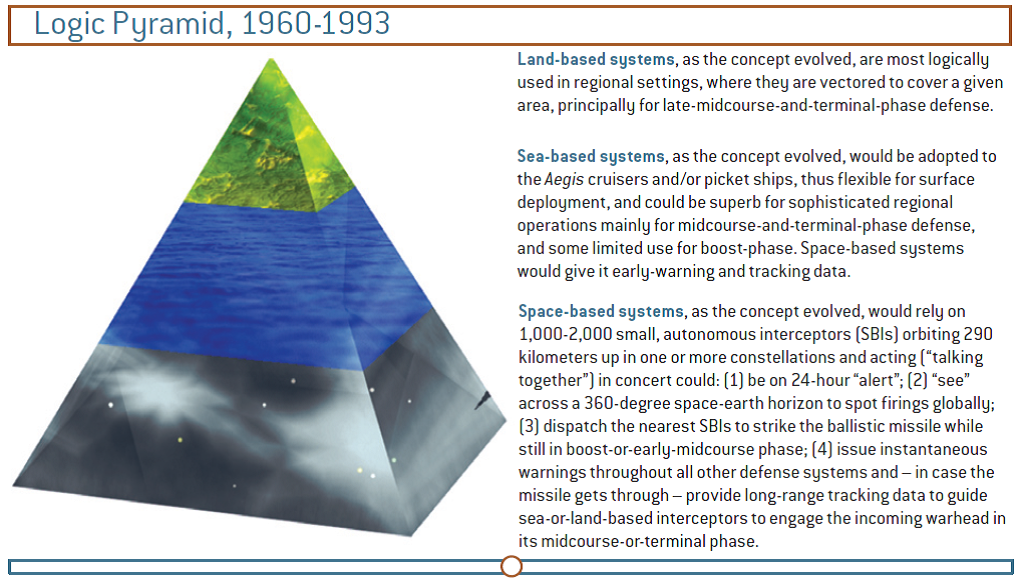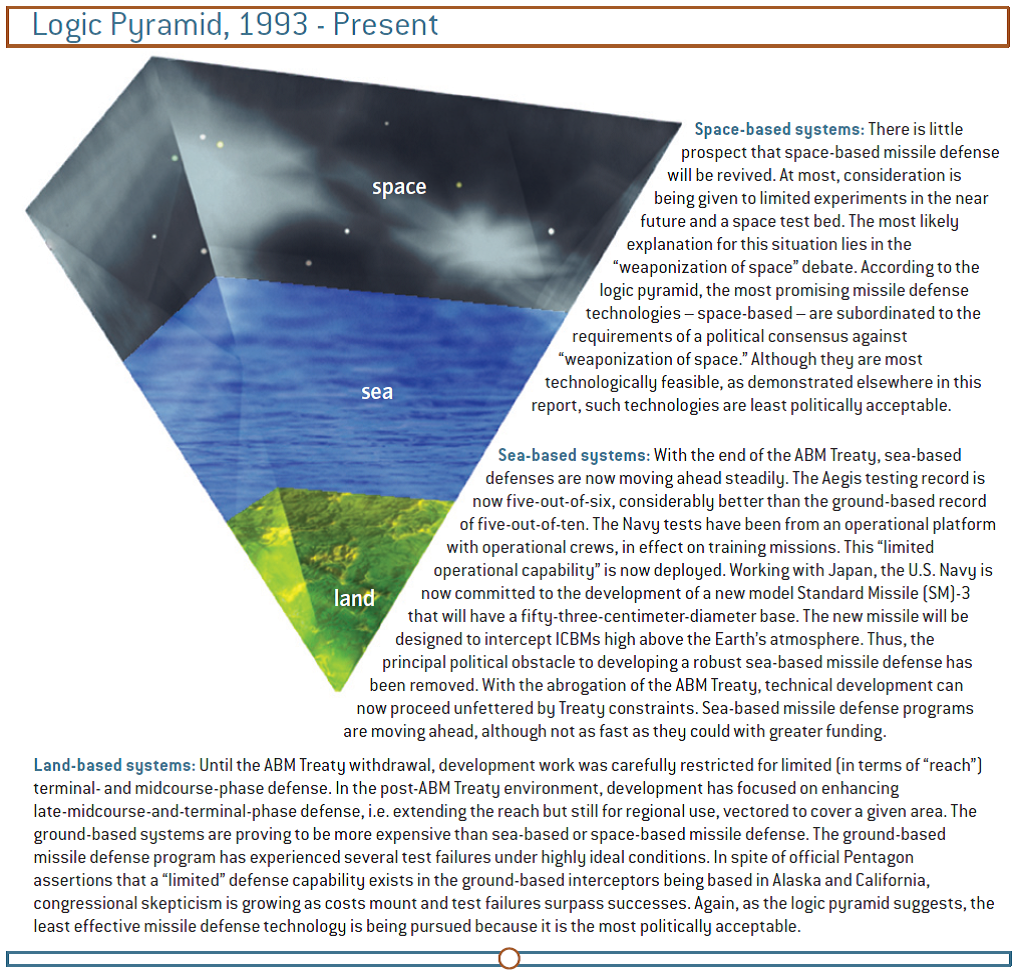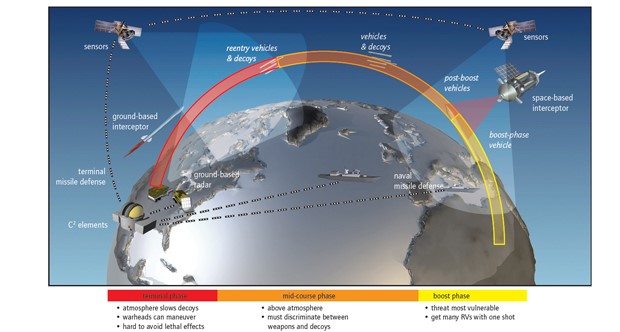To counter increasingly recognized threats, we should return to President Ronald Reagan’s vision in his March 23, 1983 speech that launched the Strategic Defense Initiative (SDI). The “powers that be” should revive technology programs aimed at developing space-based defenses, the most cost-effective way to defend against a full gamut of ballistic missile threats, including those that pose an existential electromagnetic pulse (EMP) threat.
Yesterday was the 32nd anniversary of President Ronald Reagan’s historic speech that challenged America’s best and brightest scientists and engineers to develop truly effective ballistic missile defense (BMD) systems. This decision—leading to his SDI—has been heralded by many, including yours truly, as being pivotally important in ending the Cold War.
Reagan and Thatcher: The Winning Team on SDI, Too!
Perhaps Reagan’s favorite partner, Britain’s Prime Minister Margaret Thatcher, said it best when I hosted her at SDI’s National Test Facility (NTF) in Colorado Springs on August 3, 1990:
“I firmly believe that it was the determination to embark upon that SDI program and to continue with it that eventually convinced the Soviet Union that they could never, never, never achieve their aim by military might because they would never succeed.” … British Prime Minister Margaret Thatcher, August 3, 1990
It is appropriate to include Lady Thatcher in remembering President Reagan’s famous speech that launched SDI, which she memorably said ended the Cold War “without firing a shot.” In my opinion, the Berlin Wall was torn down as a direct result of the leadership of Ronald Reagan and his unswerving partner, during the period it was my privilege to serve in the Reagan and Bush-41 administrations. We owe them both a great debt.
Click here to see and hear the important sections of President Reagan’s 1983 address. You might read again last year’s “SDI anniversary” message, which gave an abbreviated history of subsequent key events and asserted that the “powers that be” need to return to Reagan’s original vision, formally begun by his January 6, 1984 National Security Decision Directive 119 (NSDD 119) that established the SDI program.
Reagan’s vision included a major role for space-based defenses—no doubt, a major reason why his critics derisively referred to SDI as “Star Wars.” His insistence on including such defenses was demonstrated in the October 11-12, 1986 Reykjavik Summit, when he walked out because then Soviet General Secretary Mikhail Gorbachev insisted that testing of space-based defenses be limited to the laboratory. As then Chief of the Soviet General Staff, Marshal Akhromeyev, said at the time, “That was a watershed event.” As a student of the “Revolution in Military Affairs” associated with advancing technology, Akromeyev understood the implications of SDI space technology advances—advances the Soviets could not match. We pocketed Gorbachev’s important concessions that led to major reductions in offensive nuclear systems but never wavered on SDI, especially in exploring the impressive potential of space-based defense components.
Viewed from my post leading the Defense and Space Talks with the Soviets in Geneva, Reykjavik changed the entire dynamic of our negotiations—and shortly thereafter Reagan’s “Peace through Strength” agenda paid political dividends with the 1987 INF Treaty (now being violated by Vladimir Putin’s Russia) and the 1991 START Treaty—for the first time actually reducing the world’s nuclear arms, while SDI continued exploring advanced technology.
Certainly, Prime Minister Thatcher understood the importance of space-based defenses in Reagan’s agenda, and she made that clear in the remainder of her August 1990 comments at the NTF and in my several discussions with her:
“I believe that led, too, to an assessment of the poverty of their own system and to require them to admit that it produced neither prosperity nor human dignity and therefore led to the reassessment and the enormous change in East-West relations that we are seeing now.
“But Ladies and Gentlemen, there is always and will always be evil in human nature and we never know where the next threat may come from. Indeed in the last two days we have had vivid evidence of that. So we must always keep our defenses sure and we must always keep our technology well ahead.
“I therefore remain firmly behind this program. I am very pleased and proud that we have a few people from our country associated with it.
“I should like to congratulate all of you who are involved in it and all of you who in particular have given us such vivid demonstrations and such clear demonstrations of precisely what each of you is doing. It is remarkable how far it has come since 1983 when it was first initiated.
“Of course it has acquired a new kind of vocabulary of its own. What is it—the direct energy technology, the sensor technology, the interceptor technology, as well as brilliant pebbles?
“May I say that as a politician who has to answer questions in our House of Commons twice a week, I feel a great fellow-feeling with some of the vocabulary because I feel that every Tuesday and Thursday I use directed energy to intercept questions which I had already sensed and which have given me enough warning to fire the button to fire the brilliant pebbles to defeat the questions.
“Thank you very much for what you are doing. I hope that with your work and the resolve of politicians and peoples of countries which believe in freedom that we shall be able to have a very long period of peace so long as we are always ready, so long as we are always sure and so long, as Winston Churchill put it, as your country and mine stand together the world will always be free.”
Notably, these comments came as we recalled the 1940 Battle of Britain the day after Saddam Hussein invaded Kuwait. A few months later the Gulf War demonstrated the importance of having ballistic missile defenses—even a primitive BMD system, the then-untested Patriot. All Patriot interceptors employed in the Gulf War were produced between our Colorado discussions and the January 1991 operations. Most don’t realize Patriot was deployed before its testing was complete and it became a political hero of that conflict, whatever its technical merits may have been.
We knew we could do much better; and were well on our way before Defense Secretary Les Aspin two years later at the beginning of the Clinton administration famously “Took the stars out of Star Wars,” as he said—a reflection of scuttling the entire space-based defense effort and associated cutting edge technology programs, while also cutting everything else and renaming the SDI program inherited by the Clinton administration. Those key technologies, the best of the SDI era, remain dormant today.
Back from the Future?
Frankly, I am glad they renamed the program—subsequent BMD programs, by whatever name, lost Reagan’s vision, which emphasized employing the best technology America could produce without precluding any possibility, whatever the prior political correctness constraints. In particular, “Brilliant Pebbles”—the most cost-effective product of the SDI era—was abandoned for political not technological reasons. This assessment reflects the views of the SDI Directors of the “the SDI era”—1983-93—before the Clinton administration gutted the SDI program. The Pentagon’s Defense Acquisition authorities, after numerous critical reviews by the Defense Science Board and the JASON—an outside panel of academic experts, approved it in 1989 to enter formal concept validation.
There is little surprise that recent events demonstrate the consequences of failing to heed Lady Thatcher’s challenge: “[W]e must always keep our defenses sure and we must always keep our technology well ahead.”
Last week, a Reuter’s article reported that the Pentagon is conducting a major review of missile defense programs and capabilities, after military commanders called the current strategy “unsustainable” given tough budget pressures and rising threats around the world. Related testimony from senior administration officials about current missile defense programs reinforced this message last week. Consequently, House Armed Services Committee, Strategic Forces Subcommittee Chairman Mike Rogers (R-AL) provided a press release that he would not support the House Budget Committee’s funding level for Missile Defense. Stay tuned.
But the problem is more than lack of money. I can’t help but emphasize that our military commanders’ conclusion is not surprising to those of us in the Independent Working Group (IWG), which carefully considered “Missile Defense, the Space Relationship & the 21st Century.” After an intensive review, we concluded in 2007 and updated in 2009 that since 1993, we have not invested in the most effective, least costly BMD system concepts—those based in space.
McMichael’s Pyramids.
To illustrate how politics has distorted the technical possibilities, Mr. R. Daniel McMichael conceived in our IWG deliberations the following two annotated figures. He was the primary author of the most excellent, well documented Fourth Chapter of the linked IWG report—“Historical Analysis of the Politics Against Missile Defense,” which I urge all to read—pages 52-72.
The first figure illustrates the evolution of technological possibilities from the studies of BMD systems concepts from the early Defense Advanced Project Agency (DARPA) studies of the 1960s though the SDI era (March 23, 1983-January 20, 1993). The DARPA studies recognized that space-based defenses could eventually be the most cost-effective way to provide a global defense that could intercept ballistic missiles in all their phases of flight, beginning in their boost-phase before the effective countermeasures of concern today could be deployed. Multiple subsequent intercept opportunities would also occur during the longer attacking missile’s flight toward its target, provided the anticipated “midcourse offensive countermeasures” could be defeated. As SDI efforts demonstrated, intercept opportunities would also exist after the attacking missile components re-enter the atmosphere in its terminal phase.

Such space-based systems would be the technologically-based foundation for an effective global defense and the base of McMichael’s pyramid—if technology can support that architecture. At the time of the 1960 DARPA study, the technology would not support such a system; by 1989 it could, according to Pentagon Defense Acquisition officials. Had we continued development of such space-based systems, they would be available today to intercept ballistic missiles of all ranges greater than a few hundred miles—launched from anywhere on earth toward any other target.
The next most effective global defense would be sea-based because most of the earth’s surface is water, and so sea-based defenses between the launch site of threatening ballistic missiles and their targets could have numerous intercept opportunities while the attacking missile flies on its trajectory through outer space—the “exo-atmospheric” midcourse phase of its flight trajectory. Least flexible would be ground based defenses which cannot easily get near threatening launch sites, and so generally are restricted to being located near the area to be defended.
When all basing modes are available, the optimum arrangement of a global defense would place top priority on basing the defense in space that can intercept ballistic missiles in their boost phase as well as throughout their flight trajectory, next at sea focused on mid-course portion of the threatening trajectory, and finally on terminal land-based defenses focused on the final stage of the threatening missile trajectory.
By 1993, thanks to President Reagan’s SDI program, the technology demonstrated that cost-effective space-based defenses were feasible—indeed the Brilliant Pebbles program was formally approved in 1989 by the Pentagon’s Defense Acquisition Authorities to enter the Concept Validation Phase—with formal cost estimates of $10 billion (in 1988 dollars) for acquiring, deploying, operating in orbit, and replacing once each of 1000 Brilliant Pebbles interceptors. (See the February 1991 briefing to the press by then Assistant Defense Secretary Stephen Hadley’s and me, announcing my redirection of the SDI program to pursue what I still believe is the right answer for a global defense—we called the concept GPALS for Global Protection Against Limited Strikes.)
Notably, we introduced the possibility of sea-based defenses—and the Navy became supportive of including that concept in the theater missile defense (TMD) component of GPALS. So, by the end of the Bush-41 administration, we were on a track to provide the national authorities the option of building an effective global defense according to McMichael’s logic pyramid pictured above.
This was Reagan’s legacy when I left the picture as SDI Director in 1993. After then, political concerns dominated the picture—and turned McMichael’s pyramid on its head, as illustrated below, which regrettably is where we are today.

How McMichael’s Pyramid Was Inverted.
Above, I noted the regression of the Clinton administration—which focused its top priority on “strengthening” the Anti-Ballistic Missile (ABM) Treaty as the “cornerstone of strategic stability” rather than building truly cost-effective BMD systems. Actually, the regression began during the later days of the Bush-41 administration when congressional leaders demanded that the priority be placed on ABM Treaty-compliant ground-based missile BMD systems—the least effective component of the technological logic pyramid—at the expense of the investments in the other components—especially the most effective component of the technological logic pyramid. But, thanks to some stalwart SDI supporters in congress, over $300 million was appropriated in 1993 for continuing a technology demonstration program for space-based defenses.
However, when Mr. Aspin migrated from his seat as Chairman of the House Armed Services Committee to the Pentagon as Secretary of Defense, even that technology demonstration effort was cancelled and all related advanced technology programs ended—and the professionals who had been working in this area were dispersed—and the associated SDI files were purged. Happily, bi-partisan congressional support continued for developing sea-based TMD defenses then in its infancy, so at least the next most technologically desirable basing mode continued.
But politics prevailed over technological possibilities and McMichael’s depiction of an appropriately proportioned pyramid based on technical considerations was turned on its head.
Legacy Today and Some Opportunities.
That misguided set of priorities (from a technical perspective) still prevails politically. Even though President George W. Bush withdrew from the ABM Treaty in 2002 removing all restrictions other than politics, nothing was done to exploit the space-based interceptor technology that I was pursuing a decade earlier as SDI Director in his father’s administration. This situation remains in the Obama administration, which apparently is finally waking up to the well known facts-of-life that the missile defense systems so far developed are not responsive to the advancing threat.
I should note that the 2009 IWG Figure annotation above is out of date: The Aegis BMD system test record is now 29-out-of-35 attempts, including shooting down a satellite in 2009 and thereby demonstrating an ability to intercept intercontinental ballistic missiles (ICBMs). No doubt for political reasons, Aegis BMD is not yet being used to enhance the more expensive ground-based BMD sites in Alaska and California—coincidentally struggling to improve their much less impressive test record.
I am proud that the Aegis BMD system that began on my watch as SDI Director is now deployed around the world on 33 Aegis ships, growing to 35 by 2016. And a ground-based “Aegis Ashore” version is operational in Romania and will be operational in Poland in 2018. We need several such sites around the Gulf of Mexico to defend against ballistic missiles launched at us from the South—e.g., from vessels in the Gulf and from Venezuela, which trades with Iran.
Perhaps because of its heritage as a TMD system, Aegis BMD is not generally included in considerations for defending the U.S, homeland against ICBMs—but it should be. Furthermore, we should invest to make it “all it can be” by exploiting the technology artificially stifled over 20-years ago when Les Aspin “Took the stars out of Star Wars.”
Also, on this anniversary of Reagan’s historic speech that launched his SDI program, I again emphasize that we should return to Reagan’s vision in which space-based defenses played a major if not dominant role. To do so will require outside pressures to influence “today’s powers that be,” who as yet have shown no sign of heeding the IWG conclusions and recommendations.
At least, a growing number of observers at long last seem to understand we need a global defense—as I concluded in a detailed study for President George H.W. Bush and then Defense Secretary Dick Cheney in March 1990. But they seem intent on pursuing missile defense architectures that gives priority to the most-expensive, least-effective BMD system concepts—and little if any investment in the most cost-effective global space-based defense.
We called the integrated system Global Protection Against Limited Strikes (GPALS) because it was designed to defeat limited attacks launched from anywhere to attack America or our overseas troops, friends and allies. For the first time, SDI emphasized developing Theater Missile Defense (TMD) systems, including Patriot, THAAD, the Navy’s Aegis BMD system, and the Israeli Arrow System—all now operational in various locations around the world.
GPALS also included several ground-based BMD sites to help defend the United States—not unlike the sites now deployed in Alaska and California. Thus, essentially all BMD systems being pursued today were included in our GPALS concept—but notably missing from current programs is its most cost-effective component, the space-based element.
That missing space-based component in fact carried most of the defensive load—and had the full architecture indicated in the below figure continued to guide our missile defense programs, I have no doubt that Rep. Rogers would not have the concerns that led to his announcement mentioned above.

As it is, our defenses have obvious “holes” even beyond the concerns discussed in congress last week, which were primarily associated with maintaining a defense against improving ballistic missile systems that threaten the United States from over the North Pole as indicated above. Of greater concern to me is that we have no defense against ballistic missile attacks that approach U.S. targets from the South—e.g., from North Korean or Iranian satellites (systems which they have de facto tested in such “southern” launches) or from vessels in the Gulf of Mexico, or even Venezuela which partners with Iran.
Go Back to the Future!
Bottom line: Our current BMD systems are deficient, as Reuters reported and administration experts have testified. But the problem is actually worse that they report, because we have “left the back door entirely open.” To address this issue properly, we need to revive Ronald Reagan’s vision for truly effective defenses—including space-based defenses which have been neglected for over 20-years. In the nearer term, we can exploit the Aegis BMD systems to counter the threat from the South.
The powers that be should initiate studies to build space-based interceptors to provide a high confidence defense against all ballistic missile attacks, including EMP attacks from high altitude satellites. As we learned during the SDI era, such defenses are the most cost effective defenses that we can build—by a large margin. As the Iron Lady said, “[We] must always keep our defenses sure and we must always keep our technology well ahead.”
In short, we need to reset McMichael’s pyramid. Perhaps Defense Secretary Ashton Carter, who was SecDef Aspin’s Assistant Secretary when he “Took the stars out of Star Wars,” could help us go back to the future?
In any case, we need to Put the stars back into “Star Wars!”
Near Term High Frontier Plans.
We will continue our efforts to inform state and local authorities about the EMP threat and expand our work with the National Guard to help them gain knowledge and workable plans to help harden the grid and counter the EMP threat. This work should go hand in hand with the efforts to gain support from State legislators to expand on the excellent work in Maine and Virginia, which have passed legislation requiring serious studies of the EMP threat and the needed countermeasures to protect the electric power grid.
In particular, we will continue working with South Carolina folks to build a coalition to engage constructively with private citizens and their local and state representatives and other authorities to work with the SC National Guard in understanding and responding to this serious threat. We will expand this effort to neighboring and other states. We expect support from Cong. Jeff Duncan (R-SC) whose district includes my SC farm—who is a member of the Congressional EMP Caucus seeking legislation to counter the EMP threat.
We will be working with members of the EMP Coalition and others who are seeking to take our message across the country—especially with Bob Newman, a former Adjutant General of Virginia to help us link our SC plans more broadly and especially into the National Capital region.
What can you do?
Join us in praying for our nation, and for a rebirth of the freedom sought, achieved and passed to us by those who came before us.
Help us to spread our message to the grass roots and to encourage all “powers that be” to provide for the common defense as they are sworn to do.
Begin by passing this message to your friends and suggest they visit our webpage, www.highfrontier.org for more information. Also, please encourage your sphere of influence to sign up for our weekly e-newsletter.
Encourage them to review our past email messages, posted on www.highfrontier.org, to learn about many details related to the existential manmade and natural EMP threats and how we can protect America against them. I hope you will help us with our urgently needed efforts, which I will be discussing in future messages. Click here to make your tax deductible gift. If you prefer to mail a check, Please send it to 500 North Washington Street, Alexandria, VA 22314
E-Mail Message 150324
Please click here to read Past Weekly Updates!
Please help High Frontier continue this important and timely work!
 Be sure to follow us on our Social Sites!
Be sure to follow us on our Social Sites!
![]()
![]()
![]() If you found this letter via our Social Sites, and you would like to subscribe, please click below!
If you found this letter via our Social Sites, and you would like to subscribe, please click below!





